 by "ttyymmnn" (ttyymmnn)
by "ttyymmnn" (ttyymmnn)
Published 02/13/2017 at 12:35
 by "ttyymmnn" (ttyymmnn)
by "ttyymmnn" (ttyymmnn)
Published 02/13/2017 at 12:35
Tags: wingspan
; planes you've (probably) never heard of
; planelopnik
STARS: 11
From the
Planes Youíve (Probably) Never Heard Of Department
of
Wingspan
, we bring you the
Consolidated Vultee XP-81
.
!!! UNKNOWN CONTENT TYPE !!!
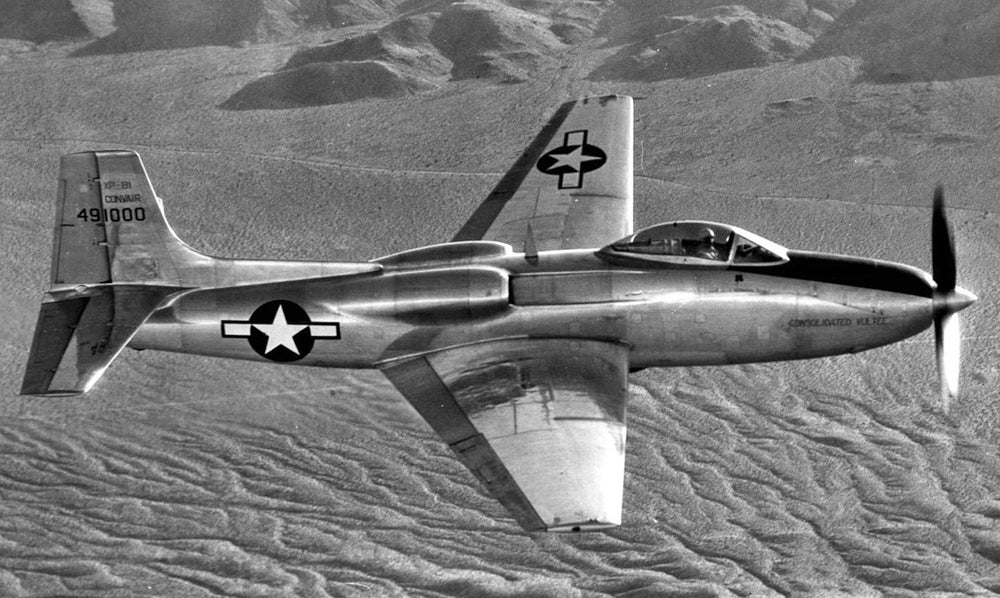
We tend to think of the turbojet engine as a product of the closing stages of WWII. However, the first jet-powered airplane, the
Heinkel He 178
, took its first flight in 1939. The German Luftwaffe was the first to field a jet-powered fighter with the
Messerschmitt Me 262
, and it was followed by the British
Gloster Meteor
, the first Allied jet fighter to enter service. But early American attempts to harness the new jet technology with the
Bell P-59 Airacomet
were disappointing at best. The turbojet engine was clearly the future of aviation, but jet engine technology of the mid-1940s was still a relatively new field, while propeller technology was reaching its zenith. So designers at Consolidated Vultee (later
Convair
) decided that it might be possible to combine the two into a hybrid turbojet/turboprop aircraft and enjoy the best of both worlds.
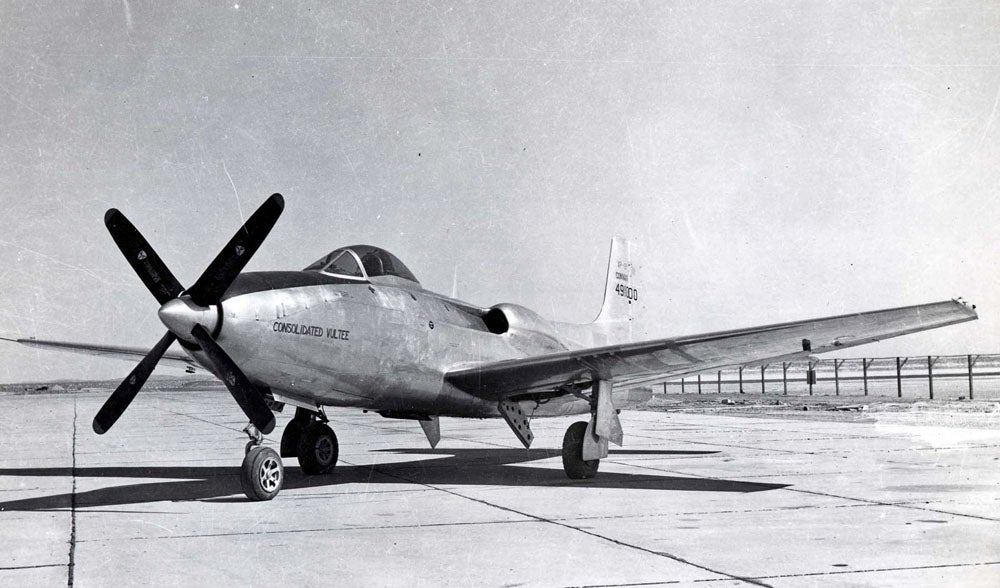
By the summer of 1944, the
Boeing B-29 Stratofortress
was flying its first bombing missions against Japan, first from bases in China, then from island bases in the Pacific. However, with bases so far from the Japanese homeland, the US Army Air Forces needed a long-range fighter capable of escorting the bombers to and from the target. A turbojet-only aircraft wasnít feasible, as early turbojets were notoriously thirsty and had significantly shorter range compared to traditional piston-powered fighters. So Consolidated Vultee took a radical approach to the problem, developing the XP-81 in the hopes of having an aircraft that enjoyed the higher speed of a turbojet but the longer range of a propeller plane. For takeoff and high speed dashes, the XP-81 would rely on an
Allison J33
turbojet in the rear of the aircraft, with air fed to it by a pair of intakes mounted high on the center of the fuselage. For long range cruising, a more efficient
General Electric TG-100
(later designated T-31) turboprop was mounted in the front and turned a four-bladed propeller.
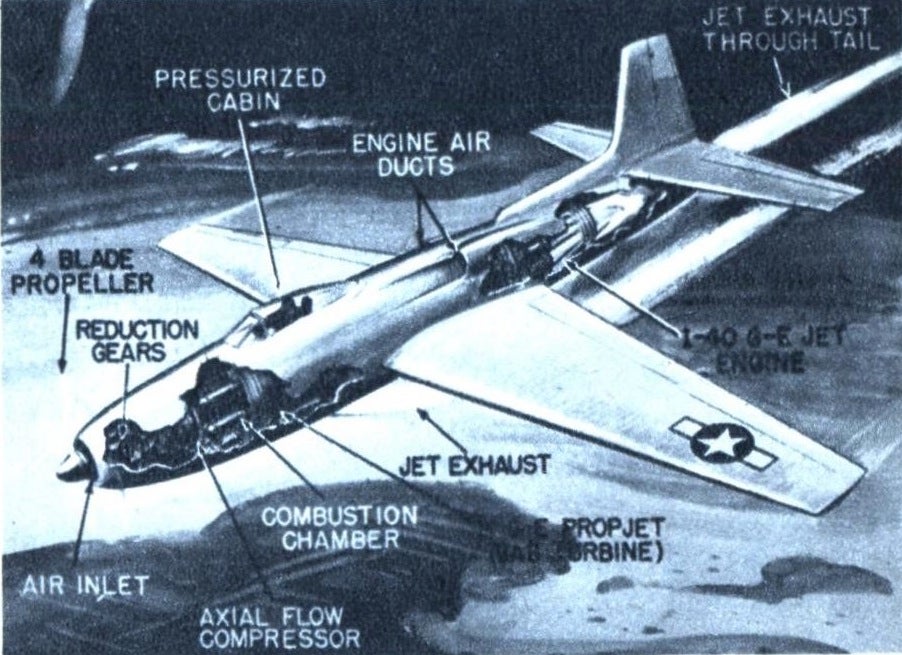
The Army Air Forces ordered two prototype aircraft for testing, and the maiden flight took place on February 11, 1945. However, as was often the case with cutting-edge designs, engine development lagged behind the construction of the airframe, and the XF-81's turbojet engine was ready while the turboprop was still under development. In an effort to get flight testing started, the XP-81 was fitted with the nose section of a
North American P-51D Mustang
housing a
Packard V-1650 Merlin
V-12 engine. After about 10 hours of flight testing, the aircraft was returned to Consolidated to have its new turboprop fitted, and the XP-81 gained the distinction of being the first American aircraft to fly under turboprop power. However, the new turboprop did not produce anywhere near as much horsepower as Consolidated had hoped. In fact, the T-31 only managed a mere 200 hp more than the Merlin, and the XP-81 showed practically no improvement in performance with the turboprop.
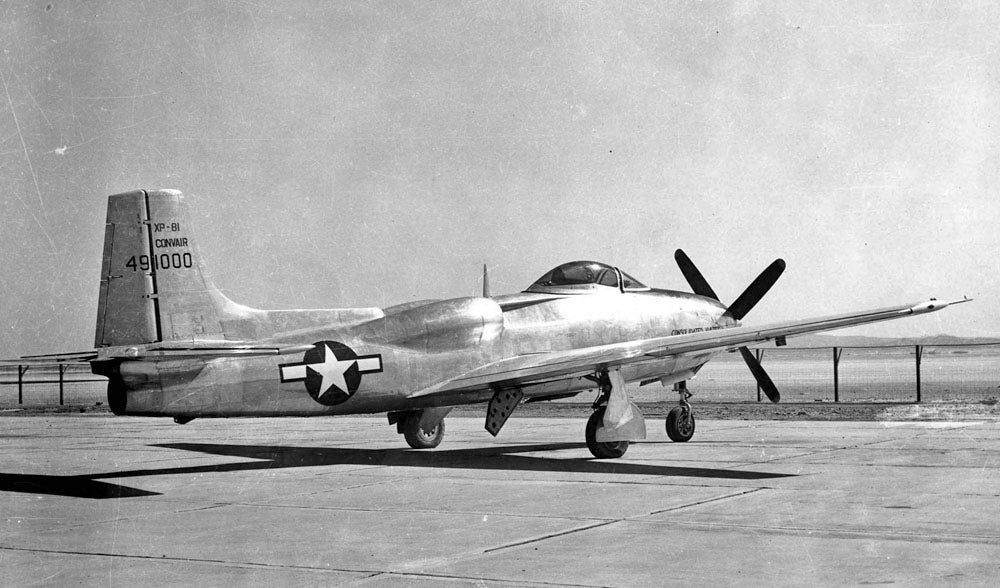
Consolidated had hoped that, with the combined power of both engines, the XP-81 would be capable of a maximum speed of 507 mph and have a cruising speed of 275 mph with just the turboprop. The large fighter held 811 gallons of fuel, and range was calculated to be 2,50o miles, nearly twice that of the
Lockheed P-38 Lightning
. But by the time flight testing had been completed, the islands of
Saipan
and
Guam
had been captured, and the USAAF no longer had a need for such a long-range escort fighter. The order for 13 XP-81s was canceled, though testing of the two prototypes continued until 1947. Both aircraft were then relegated to a bombing range where they served as photo reconnaissance targets. Fortunately, the two prototypes were not broken up for scrap, nor were they destroyed by bombs, and they are currently in storage at the
National Museum of the United States Air Force
awaiting restoration.
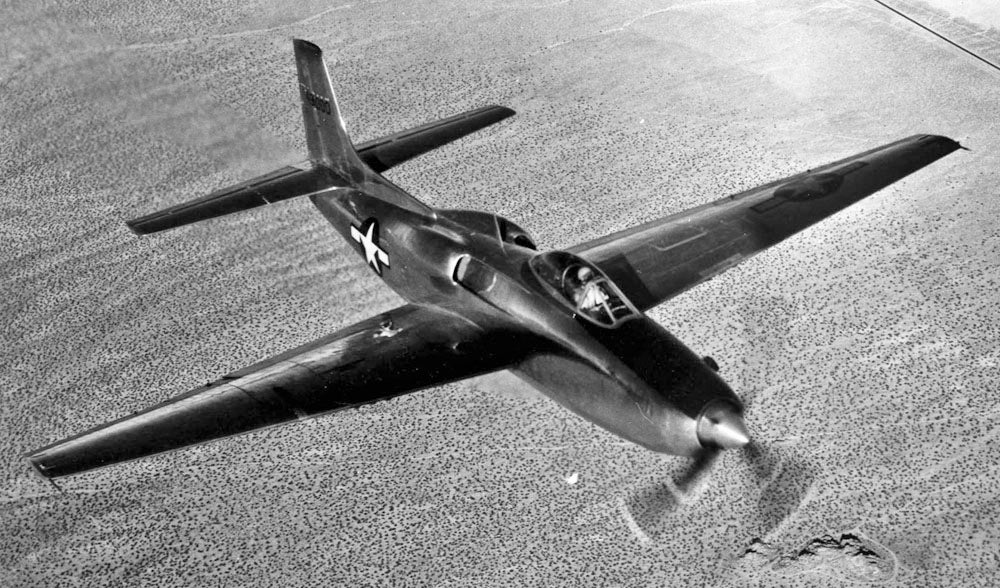
The US Navy would make their own attempts at hybrid power with the Ryan FR Fireball , an unfortunately named aircraft that actually entered production and service, though it was far from successful, and the piston engine was intended only as an insurance policy against the unreliable early turbojets. Other traditional propeller aircraft supplemented their piston engines with jets to achieve more speed or lifting power. And the Republic XF-84H went the other way, adding a supersonic propeller to the front of an F-84F Thunderstreak . But, as jet and turboprop technology matured, the idea of the hybrid fighter was eventually left behind.
!!! UNKNOWN CONTENT TYPE !!!
!!! UNKNOWN CONTENT TYPE !!!
!!! UNKNOWN CONTENT TYPE !!!
!!! UNKNOWN CONTENT TYPE !!!
!!! UNKNOWN CONTENT TYPE !!!
!!! UNKNOWN CONTENT TYPE !!!
!!! UNKNOWN CONTENT TYPE !!!
!!! UNKNOWN CONTENT TYPE !!!
If you enjoy these posts, please join in the conversation and let me know. If you missed an episode, you can find them all at Wingspan . Other aircraft also-rans can be found at Planes Youíve (Probably) Never Heard Of .
!!! UNKNOWN CONTENT TYPE !!!
 "Andy Sheehan, StreetsideStig" (AndySheehan-StreetsideStig)
"Andy Sheehan, StreetsideStig" (AndySheehan-StreetsideStig)
02/13/2017 at 12:42, STARS: 2
Great story! Definitely a plane Iíd never heard of. Man, that thing looks cool!
 "ttyymmnn" (ttyymmnn)
"ttyymmnn" (ttyymmnn)
02/13/2017 at 12:46, STARS: 2
It is cool, and it is BIG. But still not as big as the Boeing XF8B .

02/13/2017 at 13:59, STARS: 0
See, they should have had Allison develop the turboprop and GE do the jet .
Now that Iím thinking about it, has anyone actually done a turboprop fighter? The Westland Wyvern was a strike aircraft, but it had a short service life, and the early ones had a bad habit of flaming out during the cat shot.
 "ttyymmnn" (ttyymmnn)
"ttyymmnn" (ttyymmnn)
02/13/2017 at 18:05, STARS: 1
The Fairey Gannet had a double turboprop engine ( Armstrong Siddeley Double Mamba ), but that was an ASW aircraft. Thereís the Super Tucano, but thatís also primarily a ground attack/COIN aircraft, as was the Piper PA-48 Enforcer. Of course, the USAF has the Texan II, but that is a trainer, though the AF is making noises about converting it into a cheap ground attack aircraft. But a dedicated fighter ? I canít think of one.
 "Rusty Vandura - www.tinyurl.com/keepoppo" (rustyvandura)
"Rusty Vandura - www.tinyurl.com/keepoppo" (rustyvandura)
02/13/2017 at 23:26, STARS: 0
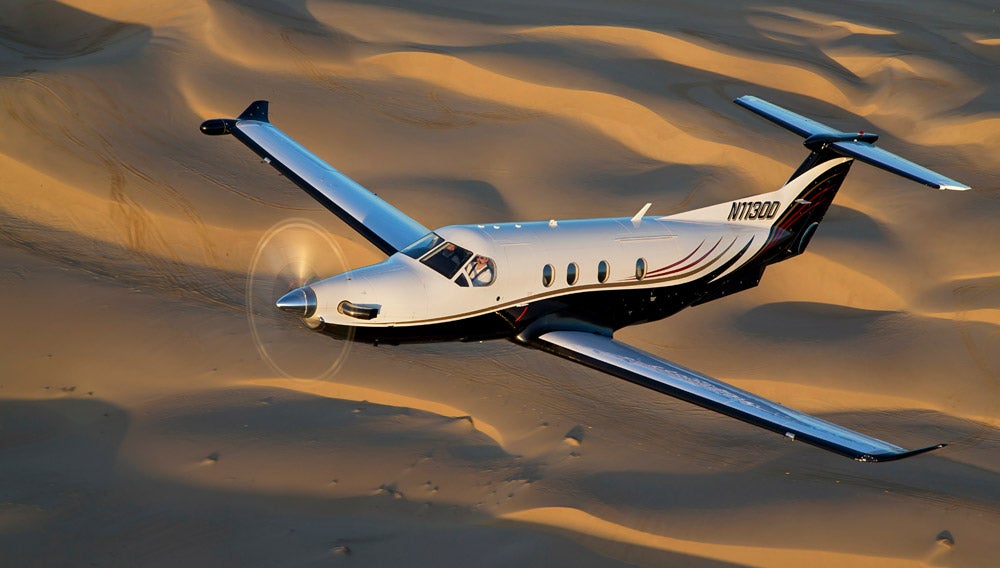

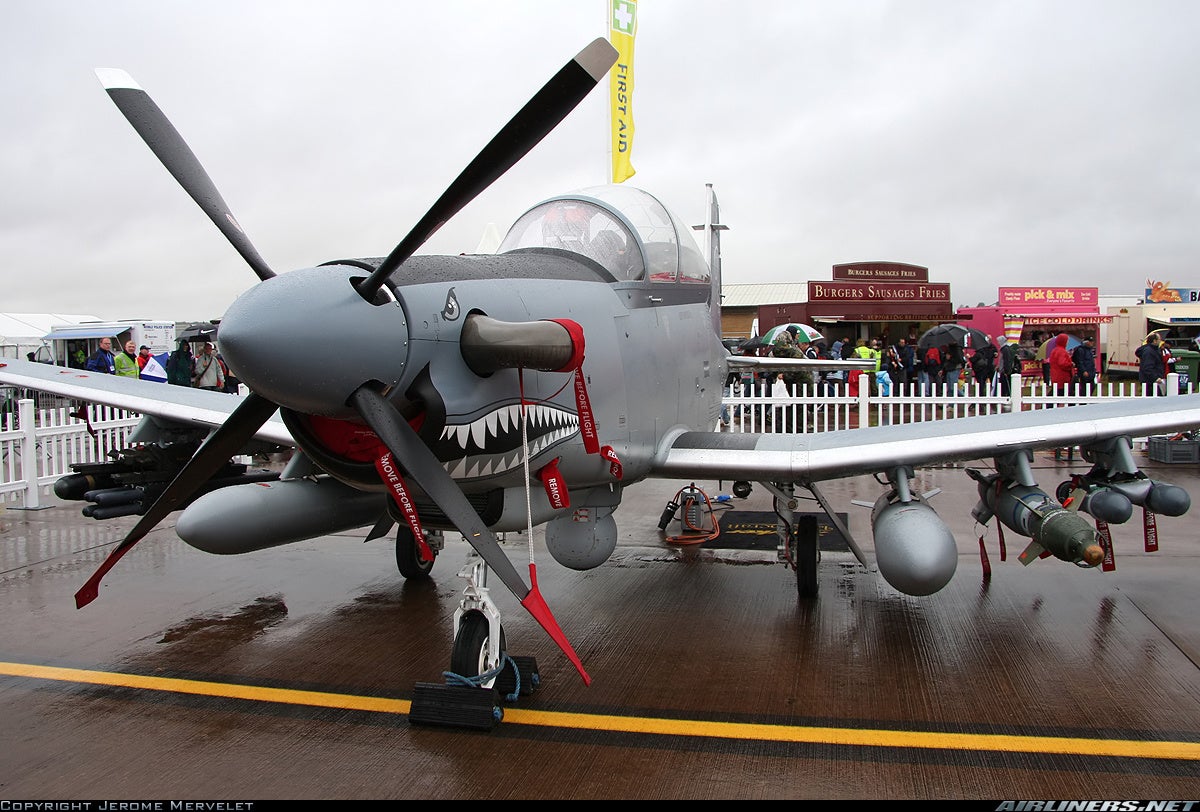
What is this? Do you have your own column now?
 "ttyymmnn" (ttyymmnn)
"ttyymmnn" (ttyymmnn)
02/13/2017 at 23:39, STARS: 0
No, just a new aviation blog to replace This Date in Aviation History. However, Iím thinking about restarting that now that my audition is over. It has been on hiatus since 12/31/16.